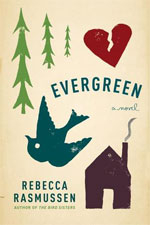I’m delighted to welcome Celia Ristow as the latest guest reviewer to contribute to this blog. Celia is a respected technical communications professional with an abiding love for literature of all kinds. She offsets many hours spent in front of a computer with ample hammock-and-good-book time.

At times touching and poignant, at others brutal, tragic and refreshingly honest, Rebecca Rasmussen’s Evergreen is a study in contrasts; and yet throughout, the story moves forward with the certainty and ease of time itself. Like the river that flows through the centre of this multi-generational epic, and the enduring beauty of the natural foliage for which it is named, Evergreen is a story of endurance, resilience and promise. Although somewhat overstated at times, Rasmussen carefully and skillfully develops a delicate balance between contrasting forces — contrasts in character, story and setting — emerging in the end as an unquestionable narrative of hope and redemption.
The plot opens with newlyweds, Eveline and Emil, as they set up their first home in Evergreen, a remote corner of the Minnesota woods in the 1930s. After Eveline’s somewhat unconventional arrival at their wilderness cabin — a Lady of Shalott figure, asleep in a rowboat without paddles — she and Emil eke out an existence from the land and river around them. It is a traditional, if somewhat familiar tale of two pioneers in unforgiving surroundings, full of struggle yet reward, a new baby boy, Hux, and marital happiness, until Emil must return to Germany to care for his ailing father.
The story becomes centered around a trio of characters at this point — all of whom paint a portrait of compelling conflicts and contradictions — as Eveline is sustained by her straight-talking, rough-around-the-edges neighbour and friend, Lulu, and her husband, Reddy. Rasmussen brings the characters of Lulu and Reddy to life with ease. Like her worn coonskin coat, Lulu has endured much and survived with a clear and unflappable view on the events and people around her. She accepts and cherishes Reddy for who he is — the “honourable” alcoholic who travels to town for regular drunken binges, but always returns with supplies; who once saved Lulu from a life of prostitution and now fills the role of “good father” to her son, Gunther. Within the larger story, Lulu and Reddy are two characters who have lived and continue to play out Rasmussen’s theme of hope and the redeeming power of love.
Like the somewhat tarnished pasts of Lulu and Reddy, the idyllic tale of Eveline and her friends is suddenly tarnished itself with the rape of Eveline by a seemingly charming government surveyor, Cullen O’Shea, and the subsequent birth of a baby girl. Here Rasmussen delves into the utterly dark world of a rape victim as she explains how Eveline had “never felt so deeply hated”, conveying Eveline’s shame, fear and self-blame as she cannot seem to forget the “boyish” dimples that led her to trust O’Shea in the first place. And yet throughout this dark episode and following it, Rasmussen never lets us lose sight of the beauty and reassurance in nature, whether it be the inevitable return of spring and “tender green buds” to Evergreen or the little bird, Tuna, who feeds and sings without fail outside Eveline’s cabin.
Fearing Emil’s reaction to the baby born of this violation, Eveline leaves the baby at the Hopewell Orphanage, a name fraught — perhaps not so subtly — with the same contradictions Rasmussen has evoked previously. A place of supposed “hope”, the head nun at the orphanage develops a torn love/hate relationship with the girl, bestowing one her the demon name, Naamah. Despite dreams of finding her mother, and her view of the enduring evergreens from the orphanage — “Green as far as she could see” — Namaah inevitably leaves Hopewell and winds up a prostitute.
From here, Rasmussen moves the story forward easily, re-introducing the themes hope and redemption when Hux goes in search of and eventually finds his long-lost sister. The story now focuses on a new trio in Evergreen, Hux, Naamah and Lulu’s son, Gunther, who like the previous generation, continue to live a rough but idyllic life in their (now deceased) parents’ former cabins. As the story progresses with Gunther’s marriage to Naamah and the birth of their daughter, Racina, it becomes increasingly evident that the struggles and conflicts within Naamah have not dissipated. Afraid she “will do something terrible” to Racina, she abandons her, leaving her to be raised by the rough but dependable Gunther — a slightly over-stated echo of the past with Eveline’s abandonment of Naamah, and Lulu and Reddy’s predictability, but this thread weaves the generations and the story together in a way that seems perfectly natural and in its own way, reassuring.
Throughout Evergreen, Rasmussen evokes the beauty of the wilderness with vivid detail, taking its fundamental contradictions of brutality versus beauty, isolation versus connection as a backdrop to the struggles within the characters themselves. Occasionally somewhat forced — the image of Racina running into her mother’s arms at the conclusion of the story might seem somewhat Disney-like to some — and the evergreen imagery a little insistent at times, the story is compelling. The internal struggles of the characters are well-developed, and the plot moves forward at a steady pace so that we cannot help but read on. It’s a feel-good story, an honest portrayal of troubled lives, but reassuring in its simple yet affirmative final phrase, ‘Love was’.
Thank you to the author, Rebecca Rasmussen, for providing a complimentary copy of Evergreen.
